Original Title: "Super Week Approaches: Will Data Over the Next Three Days Determine the Crypto Market's Trends for the Second Half of the Year?"
Original Author: Deng Tong, Jinse Finance
This week will become the "data-richest week of the year" in the United States. What major events should we pay attention to over the next three days? How will the crypto market trend in the future?
1. Major Events to Watch Over the Next Three Days
1. Federal Reserve Interest Rate Meeting
At 2:00 AM Beijing time on July 31, the Federal Reserve will announce its latest interest rate decision, and Powell will hold a monetary policy press conference.
On July 28, Trump stated that the Federal Reserve must cut interest rates. Trump said, "Even without a rate cut, the U.S. is doing well, but it would do even better with a rate cut." Federal Reserve Chairman Powell's term ends in May 2026. The Federal Reserve, led by Powell, is reluctant to lower the benchmark interest rate from the current target range of 4.25% to 4.50% to 1% as Trump requested, in order to reduce the federal government's borrowing costs. Trump is dissatisfied with this and has repeatedly threatened to have Powell "removed."
"Federal Reserve mouthpiece" Nick Timiraos published an article stating that Federal Reserve officials expect they will ultimately need to continue cutting rates, but they are not yet ready to do so on Wednesday. Their disagreement lies in what evidence they need to see first and whether waiting for everything to become clear is a mistake. Officials are currently divided into three camps on whether to resume rate cuts. The focus will be on whether Powell will provide any hints about a rate cut in September during the press conference, and whether his colleagues will start laying the groundwork for the next meeting's rate cut in the coming days and weeks.
Huatai Securities research report states: Although Trump has pressured Powell to cut rates multiple times since the June meeting, some members within the Federal Reserve have also called for a rate cut in July. However, considering the overall strong job market and that tariffs will gradually translate into inflation, it is expected that the Federal Reserve will likely remain on hold in July; subsequent rate cut decisions will depend on economic data from July to August, and maintaining a weakening job market will prompt the Federal Reserve to consider two preemptive rate cuts from September to December.
Swiss bank Julius Baer believes that the Federal Reserve may restart the rate cut cycle at the September FOMC meeting. A weakening economic outlook means the Federal Reserve will implement a more accommodative monetary policy in the second half of the year. The uncertainty surrounding inflation after tariff increases and the political pressure from President Trump to cut rates have hindered a rate cut this month. After July, stagnation in private consumption and reduced investment plans (indicating softening demand) will demonstrate that, despite inflation being above target, reducing restrictive policy stances is reasonable.
According to CME's "FedWatch": The probability of the Federal Reserve maintaining interest rates in July is 96.9%, while the probability of a 25 basis point cut is 3.1%. The probability of the Federal Reserve maintaining interest rates in September is 35.4%, while the cumulative probability of a 25 basis point cut is 62.6%, and the cumulative probability of a 50 basis point cut is 2.0%.
Although a rate cut is not expected, given the ongoing neutral tone in July, the outcome of a rate cut may have already been largely digested by the market. However, any dovish remarks from Federal Reserve Chairman Jerome Powell could change market sentiment. If Powell hints at a possible rate cut in September, the market may react ahead of expectations, pushing Bitcoin to break through $123,000 and set a new high.
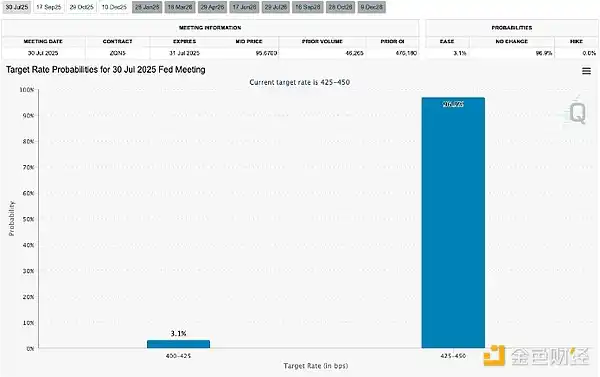
Federal Reserve July FOMC Meeting Target Rate Probabilities. Source: CME Group
2. Trump's Tariff Policy
On August 1, Trump's new tariff measures will come into effect.
On July 28, Trump stated that the U.S. is expected to impose tariffs of 15% to 20% on countries that do not reach trade agreements with Washington. After meeting with UK Prime Minister Starmer at his golf resort in Turnberry, Scotland, Trump told reporters, "I think it will be between 15% and 20%. It could be one of those two numbers." Trump indicated that the U.S. would soon send letters to about 200 countries notifying them of the expected tariff rates on U.S. exports. Since April, Trump has imposed an additional 10% tariff on most countries, and the tariff rates for many other countries will increase starting August 1. Tariff agreements in three key areas—steel and aluminum, chips, and spirits—are still pending.
Trump stated that the EU has also committed to purchasing $750 billion worth of energy products from the U.S. and to additional investments of $600 billion. Additionally, the EU will make large-scale purchases of U.S. military equipment.
U.S. Commerce Secretary Lutnik stated that Trump will make tariff decisions regarding other countries this week. Trump will consider several agreements this week and then determine the rates. For countries proposing to provide access, our negotiation table is ready.
After U.S. President Trump announced a significant trade agreement between the EU and the U.S., European Commission President von der Leyen explained some of the decisions made in the U.S.-EU trade negotiations. Von der Leyen stated that the EU currently remains overly reliant on Russian liquefied natural gas, so importing more affordable liquefied natural gas from the U.S. is very welcome. Regarding tariff arrangements, von der Leyen confirmed that the agreement sets a uniform tariff of 15% for the automotive industry. She stated that, under the current circumstances, a 15% tariff level is the best result the European Commission can achieve. Additionally, she confirmed that the EU and the U.S. have also reached an agreement in the pharmaceutical sector to implement a uniform tariff rate of 15%. Von der Leyen acknowledged that the EU and the U.S. have not yet made a decision regarding the spirits sector, and the details of the trade agreement framework signed that day will be announced in the coming weeks.
On the same day, German Chancellor Merz expressed dissatisfaction with the tariff agreement reached between the EU and the U.S., stating that the 15% tariff imposed by the U.S. on EU goods will be a significant burden for Germany's export-oriented economy. However, Merz also acknowledged that the current U.S. tariff rate on EU goods has been halved from the previously claimed 30%, and he cannot expect a better outcome.
Mosaic Asset pointed out: "The easing of trade tensions and favorable liquidity have driven the S&P 500 index to a new high, while volatility has dropped to its lowest level since the beginning of the year. M2 has rebounded from its low since 2023 and is now reaching new highs alongside major stock indices." Throughout the history of the cryptocurrency market, the performance of Bitcoin and cryptocurrencies has been closely related to global M2 liquidity trends.
3. Hong Kong's Stablecoin Issuer Regulatory Regime to Take Effect
On August 1, Hong Kong's "Stablecoin Regulation" will take effect.
The Hong Kong Monetary Authority (HKMA) announced a 6-month transition period to handle institutions that already have stablecoin issuance operations in Hong Kong, including issuing temporary licenses to issuers capable of complying with regulatory requirements. If an issuer fails to meet the relevant requirements within three months after the regulation takes effect, they must orderly wind down their operations in Hong Kong within four months after the law takes effect. If the Financial Management Commissioner does not believe the issuer is capable of meeting the licensing criteria and regulatory requirements, the issuer must orderly wind down their Hong Kong operations within one month of receiving a rejection notice.
The HKMA previously released the "Regulatory Guidelines for Licensed Stablecoin Issuers," "Guidelines for Combating Money Laundering and Terrorist Financing (Applicable to Licensed Stablecoin Issuers)," and a consultation summary for the two guidelines, which will be implemented starting August 1, 2025. The HKMA also published a summary description of the licensing system and application procedures related to stablecoin issuers, as well as a summary description of the transitional provisions for existing stablecoin issuers. The HKMA stated that no licenses have been issued to date. Institutions intending to apply for a license are encouraged to contact the HKMA by August 31, 2025, so that the HKMA can communicate regulatory expectations and provide appropriate feedback. Licensing will be an ongoing process, and if individual institutions believe they are adequately prepared and wish to be considered early, they should submit their applications to the HKMA by September 30, 2025.
Stablecoins are highly popular in Hong Kong. HKMA President Yu Weiwen published an article on July 23 titled "Stablecoins for Steady and Long-Term Development," warning against excessive speculation and the need to prevent financial risks. "We need to guard against excessive speculation in the market and public opinion; there are recent phenomena that deserve our attention: one is excessive conceptualization, but more importantly, the trend of bubble formation."
Everbright Securities released a research report stating that the global retail cross-border payment market is expected to reach $39.9 trillion by 2024. According to FXC Intelligence, this figure is projected to grow to $64.5 trillion by 2032, with a compound annual growth rate of 6.2% from 2024 to 2032. In the business levels of RMB cross-border clearing and multi-currency settlement, third-party payment institutions have deeply embedded themselves in the full-chain service ecosystem, playing an important role. It is expected that stablecoins will drive the global expansion of RMB cross-border payment infrastructure and diversify application scenarios, thus providing growth opportunities for third-party payment companies. In the long run, the development space for compliant stablecoins is vast, which will help standardize the stablecoin market, enhance investor confidence, and promote market scale expansion.
4. U.S. Q2 GDP Data to Be Released
On July 30, local time, U.S. Q2 GDP data will be released.
Data released by the U.S. Commerce Department on Tuesday showed that the trade deficit in goods narrowed by 10.8% in June compared to the previous month, falling to $86 billion. This data is not adjusted for inflation and is below the forecast of all economists surveyed by the media.
The latest U.S. June goods trade data has prompted some economists to raise their estimates for U.S. second-quarter GDP, which will be released on Wednesday. Analysts believe that the trade phenomenon that dragged down U.S. GDP at the beginning of the year is expected to be fundamentally reversed in the latest quarter.
According to the Atlanta Federal Reserve's real-time forecast, the GDP growth rate for Q2 2025 is projected to be 2.90% and 2.38%.
Goldman Sachs previously raised its second-quarter GDP growth forecast from -0.3% to 2.4%, believing that the first-quarter GDP data may have been underestimated.
Moody's Analytics predicts that U.S. GDP growth for the entire year of 2025 will be 1.5%, but believes that the second-quarter data may be slightly higher and points out that the U.S. economy will be in a "weak expansion" state.
If the U.S. Q2 GDP data exceeds expectations, the improving economy will boost investors' risk appetite, leading some funds to flow into the crypto market.
5. Non-Farm Payroll Data to Be Released
On Friday local time, U.S. non-farm payroll data will be released.
The July non-farm report released on Friday is expected to confirm that corporate hiring is becoming cautious. After a surge in employment in the education sector in June boosted the data, job additions are expected to slow this month, and the unemployment rate may slightly rise to 4.2%. The U.S. government's June personal income and spending report is expected to show that the core inflation indicator favored by the Federal Reserve has slightly accelerated month-on-month, indicating that tariffs are only gradually being passed on to consumers.
Citi analysts pointed out in a recent research report that if signs of weakness appear in the U.S. labor market, it will trigger a reassessment of more dovish expectations from the Federal Reserve, leading to a new round of declines in the dollar as funds seek new investment channels, thereby increasing the attractiveness of cryptocurrencies. Citi expects that non-farm employment growth in July will slow to 100,000, and the unemployment rate may rise to 4.2%.
6. Earnings Season for Tech Giants
On Wednesday and Thursday local time, Microsoft, Meta, Apple, and Amazon will successively release their earnings reports.
The four tech giants—Microsoft, Meta, Apple, and Amazon—will release their earnings reports on Wednesday and Thursday this week, with a total market capitalization of $11.3 trillion. Their performance will be a key test for whether the S&P 500 index can continue its upward trend. According to media data, among the approximately one-third of S&P 500 constituent companies that have reported earnings, about 82% exceeded expectations, likely achieving the best quarterly performance in nearly four years.
However, analysts have significantly lowered their expectations over the past few months, mainly due to concerns about the impact of tariffs on consumer spending and profit margins. Earnings forecasts for large tech companies have also been downgraded. Data shows that the expected year-on-year earnings growth for the "Mag7" in the second quarter is 16%, down from the 19% forecast at the end of March. Meanwhile, the expected year-on-year earnings growth rate for the S&P 500 index is 4.5%, also lower than the 7.5% forecast in March.
If the earnings reports are good, it could boost overall market optimism, increase fund activity, and potentially lead to more funds flowing into the crypto market. Conversely, if the earnings fall short of expectations, market confidence may be undermined, leading to increased demand for safe-haven assets and potential outflows from the cryptocurrency market.
II. How Will the Crypto Market Move Forward?
Although the short-term market structure outlines a bullish recovery, the long-term pattern suggests that the bullish momentum for BTC may be weakening. A double-top pattern may emerge near its historical high, reflecting buyer fatigue. If it fails to break through the daily supply zone at $123,200 decisively, this bearish pattern will be validated, hindering price discovery.
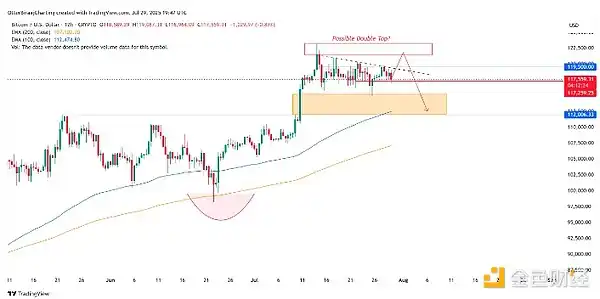
Bitcoin 12-hour chart. Source: Cointelegraph/TradingView
Bitcoin's daily relative strength index has sharply dropped from 74.4 to 51.7, indicating that the spot market is already weak, while daily trading volume has fallen to $8.6 billion, both suggesting a decline in market participation. The fund flow for spot BTC exchange-traded funds (ETFs) has also decreased by 80% from last week, dropping from $2.5 billion to $496 million, indicating that institutional investor interest is cooling.
Despite the open interest in futures remaining high at $45.6 billion, the increase in long positions suggests that market overconfidence is intensifying. Additionally, 96.9% of the supply is still in profit, indicating a high likelihood of profit-taking.
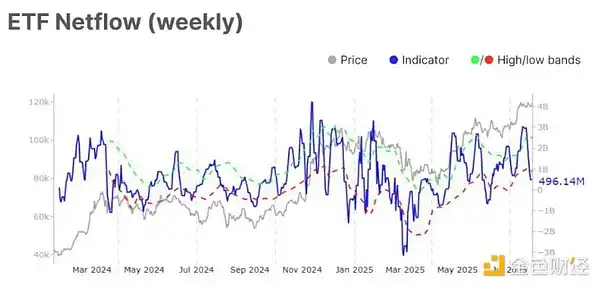
The historical returns for August further corroborate this view. Over 60% of funds closed in losses in August, with an average return of -2.56%, indicating that the upcoming month will face seasonal headwinds. Coupled with weakened on-chain activity, such as declines in active addresses and transaction volumes, BTC prices may pull back in the coming weeks.
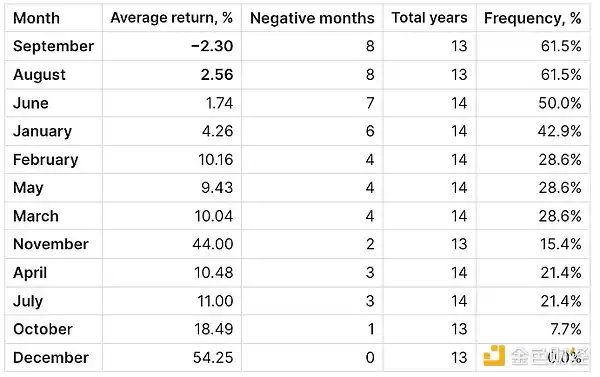
BTC historical monthly average returns. Source: Axel Adler Jr.
The latest research from on-chain analysis platform CryptoQuant suggests that the stablecoin supply ratio (SSR) has been growing in sync with BTC/USD, which may indicate a lack of liquidity in stablecoins available for investment or "dry powder."
Author Arab Chain states: "The rise of this indicator suggests that there are few stablecoins compared to the trading volume of Bitcoin. In other words, liquidity is weak, and thus the market lacks the high purchasing power to support Bitcoin. The rise of this indicator, along with the increase in Bitcoin prices, indicates that this rise is occurring without new stablecoins entering at the same rate. A continued rise in this indicator may suggest that future buying momentum could weaken due to low liquidity." The market may be entering a "temporary saturation" period. "The market is still partially supported by liquidity, but Bitcoin's sustained rise will require a significant increase in stablecoin reserves in the coming days."
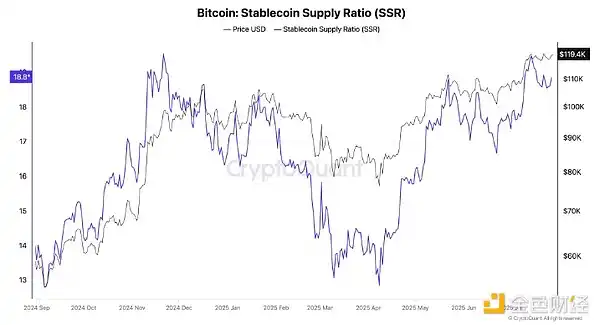
Bitcoin SSR vs. BTC/USD chart. Source: CryptoQuant
Trader Crypto Tony predicts: "If Bitcoin can tighten and hold above $117,000, then I believe we will soon set a new all-time high."
Rekt Capital states: "Currently, BTC needs to avoid breaking through the resistance at the top of the bull flag; otherwise, the price will remain within a range."
免责声明:本文章仅代表作者个人观点,不代表本平台的立场和观点。本文章仅供信息分享,不构成对任何人的任何投资建议。用户与作者之间的任何争议,与本平台无关。如网页中刊载的文章或图片涉及侵权,请提供相关的权利证明和身份证明发送邮件到support@aicoin.com,本平台相关工作人员将会进行核查。




